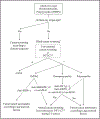The diagnostic work-up of cancer-associated myositis
- PMID: 29965856
- PMCID: PMC11611047
- DOI: 10.1097/BOR.0000000000000535
The diagnostic work-up of cancer-associated myositis
Abstract
Purpose of review: Despite the well-recognized association between malignancy and myositis, definite data indicating the best strategy for diagnosing cancer in myositis patients is lacking. In this article, we review the data on cancer screening in patients with myositis, and propose an algorithm for this purpose based on recently published data.
Recent findings: Evidence has recently emerged supporting blind screening in patients with certain myositis phenotypes. In addition to the clinical examination, imaging techniques such as PET/computed tomography scanning and whole-body MRI, and determination of the autoantibody profile beyond anti-TIF1γ antibody, the well known cancer biomarker in dermatomyositis, will help the clinician face this complex clinical situation. Molecules related to the checkpoint inhibitor pathway, specifically soluble programmed death 1, may also have a role in the diagnostic work-up of cancer in myositis. In the future, blood tests analysing circulating DNA will certainly help in detecting patients with cancer-associated myositis (CAM).
Summary: A step forward has been achieved in the pathway to establish optimal cancer screening for myositis patients. International consensus guidelines for an effective diagnostic work-up of CAM are in progress and will be of paramount importance to improving the outcome in these patients.
Conflict of interest statement
Conflicts of interest
There are no conflicts of interest.
Figures


References
-
- Qiang JK, Kim WB, Baibergenova A, Alhusayen R. Risk of malignancy in dermatomyositis and polymyositis. J Cutan Med Surg 2017; 21:131–136. - PubMed
-
- Trallero-Araguás E, Rodrigo-Pendás JÁ Selva-O’Callaghan A, et al. Usefulness of antip155 autoantibody for diagnosing cancer-associated dermatomyositis: a systematic review and meta-analysis. Arthritis Rheum 2012; 64:523–532. - PubMed
-
- Albayda J, Pinal-Fernandez I, Huang W, et al. Antinuclear matrix protein 2 autoantibodies and edema, muscle disease, and malignancy risk in dermatomyositis patients. Arthritis Care Res 2017; 69:1771–1776. - PMC - PubMed
-
In a large cohort of patients with dermatomyositis, the authors confirmed an association between cancer-associated myositis and anti-NXP2 antibody. Presence of anti-NXP2 confers a 3.68-fold increased risk of associated malignancy.
-
- Greenberg SA, Pinkus JL, Amato AA, et al. Association of inclusion body myositis with T cell large granular lymphocytic leukaemia. Brain 2016; 139:1348–1360. - PubMed
Publication types
MeSH terms
Substances
Grants and funding
LinkOut - more resources
Full Text Sources
Other Literature Sources
Medical
Research Materials

